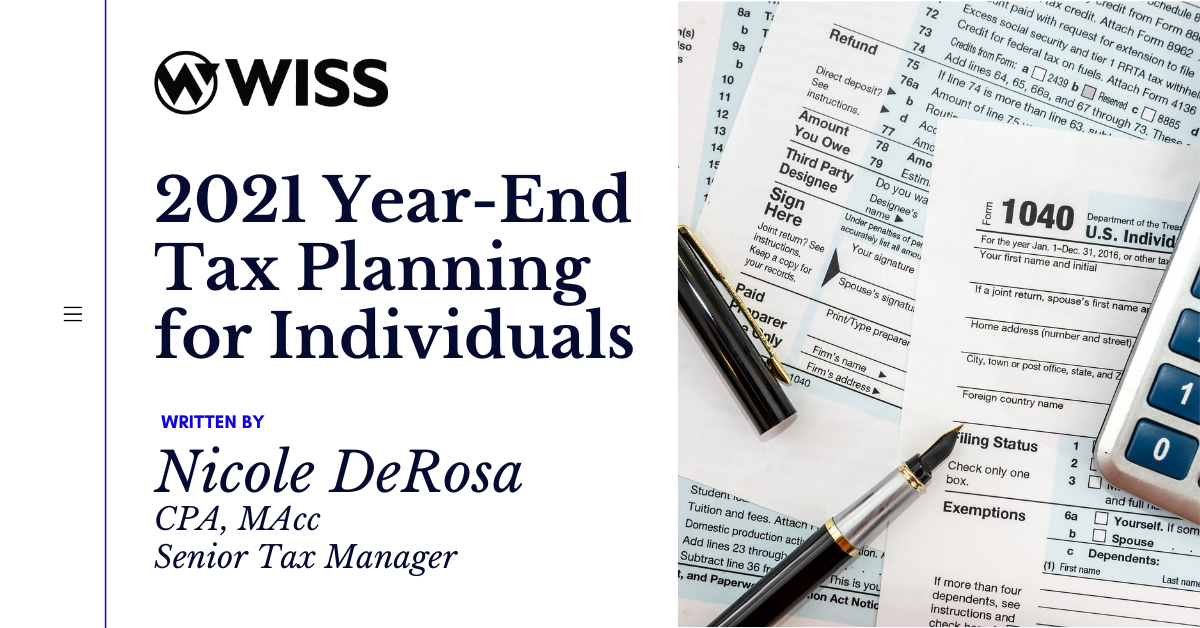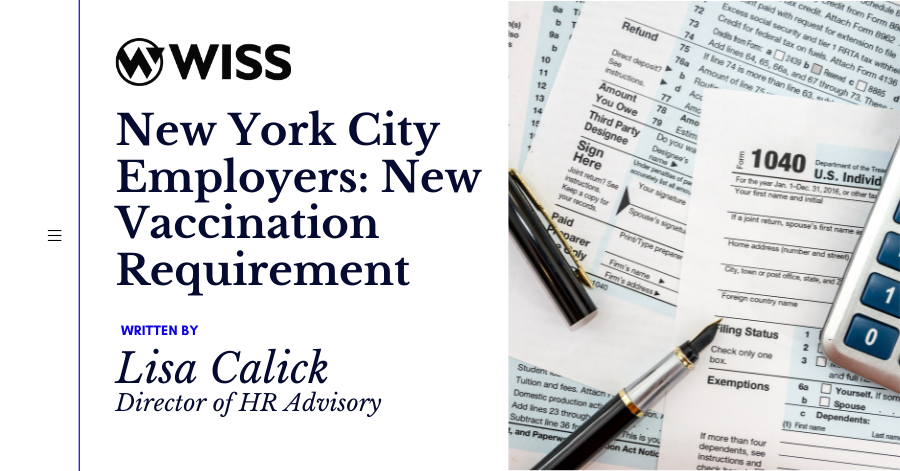As we approach year-end, now is the time for individuals, business owners, and family offices to review their 2021 and 2022 tax situations and identify opportunities for reducing, deferring, or accelerating tax obligations. Areas potentially impacted by proposed tax legislation still in play should be reviewed, as well as applicable opportunities and relief granted under legislation enacted during the past year.
The information contained within this article is based on tax proposals as presented in the November 3, 2021, version of the Build Back Better Act. Our guidance is subject to change when final legislation is passed. Taxpayers should consult with a trusted advisor when making tax and financial decisions regarding any of the items below.
For more information and to track the status of tax measures under consideration by Congress, see BDO’s Tax Policy Watch.
Individual Tax Planning Highlights
2021 Federal Income Tax Rate Brackets
[table id=48 /]2022 Federal Income Tax Rate Brackets
[table id=49 /]Proposed Surcharge on High-Income Individuals, Estates, and Trusts
The November 3rd version of the Build Back Better Act would impose a 5% surcharge on modified adjusted gross income that exceeds $5 million for married individuals filing separately, $200,000 for estates and trusts, and $10 million for all other individuals. An additional 3% surcharge would be imposed on modified adjusted gross income in excess of $12.5 million for married individuals filing separately, $500,000 for estates and trusts, and $25 million for all other individuals. The proposal would be effective for taxable years beginning after December 31, 2021 (i.e., beginning in 2022).
While keeping the proposed surcharges in mind, taxpayers should consider whether they can minimize their tax bills by shifting income or deductions between 2021 and 2022. Ideally, income should be received in the year with the lower marginal tax rate, and deductible expenses should be paid in the year with the higher marginal tax rate. If the marginal tax rate is the same in both years, deferring income from 2021 to 2022 will produce a one-year tax deferral, and accelerating deductions from 2022 to 2021 will lower the 2021 income tax liability.
Actions to consider that may result in a reduction or deferral of taxes include:
- Delaying closing capital gain transactions until after year-end or structuring 2021 transactions as installment sales so that gain is deferred past 2021 (also see Long Term Capital Gains, below).
- Considering whether to trigger capital losses before the end of 2021 to offset 2021 capital gains.
- Delaying interest or dividend payments from closely held corporations to individual business-owner taxpayers.
- Deferring commission income by closing sales in early 2022 instead of late 2021.
- Accelerating deductions for expenses such as mortgage interest and charitable donations (including donations of appreciated property) into 2021 (subject to AGI limitations).
- Evaluating whether non-business bad debts are worthless by the end of 2021 and should be recognized as a short-term capital loss.
- Shifting investments to municipal bonds or investments that do not pay dividends to reduce taxable income in future years.
On the other hand, taxpayers that will be in a higher tax bracket in 2022 or that would be subject to the proposed 2022 surcharges may want to consider potential ways to move taxable income from 2022 into 2021, such that the taxable income is taxed at a lower tax rate. Current year actions to consider that could reduce 2022 taxes include:
- Accelerating capital gains into 2021 or deferring capital losses until 2022.
- Electing out of the installment sale method for 2021 installment sales.
- Deferring deductions such as large charitable contributions to 2022.
Long-Term Capital Gains
The long-term capital gains rates for 2021 and 2022 are shown below. The tax brackets refer to the taxpayer’s taxable income. Capital gains also may be subject to the 3.8% Net Investment Income Tax above certain thresholds.
2021 Long-Term Capital Gains Rate Brackets
[table id=50 /]2022 Long-Term Capital Gains Rate Brackets
[table id=51 /]Long-term capital gains (and qualified dividends) are subject to a lower tax rate than other types of income. Investors should consider the following when planning for capital gains:
Holding capital assets for more than a year (more than three years for assets attributable to carried interests) so that the gain upon disposition qualifies for the lower long-term capital gains rate. Long-term capital gains (and qualified dividends) are subject to a lower tax rate than other types of income. Investors should consider the following when planning for capital gains:
- Considering long-term deferral strategies for capital gains such as reinvesting capital gains into designated qualified opportunity zones.
- Investing in, and holding, “qualified small business stock” for at least five years. (Note that the November 3rd version of the Build Back Better Act would limit the 100% and 75% exclusion available for the sale of qualified small business stock for dispositions after September 13, 2021.)
- Donating appreciated property to a qualified charity to avoid long-term capital gains tax (also see Charitable Contributions, below).
Net Investment Income Tax
An additional 3.8% net investment income tax (NIIT) applies to net investment income above certain thresholds. For 2021, net investment income does not apply to income derived in the ordinary course of a trade or business in which the taxpayer materially participates. Similarly, gain on the disposition of trade or business assets attributable to an activity in which the taxpayer materially participates is not subject to the NIIT.
The November 3rd version of the Build Back Better Act would broaden the application of the NIIT. Under the proposed legislation, the NIIT would apply to all income earned by high-income taxpayers unless such income is otherwise subject to self-employment or payroll tax. For example, high-income pass-through entity owners would be subject to the NIIT on their distributive share income and gain that is not subject to self-employment tax. In conjunction with other tax planning strategies that are being implemented to reduce income tax or capital gains tax, impacted taxpayers may want to consider the following tax planning to minimize their NIIT liabilities:
- Deferring net investment income for the year.
- Accelerating into 2021 income from pass-through entities that would be subject to the expanded definition of net investment income under the proposed tax legislation.
Social Security Tax
The Old-Age, Survivors, and Disability Insurance (OASDI) program is funded by contributions from employees and employers through FICA tax. The FICA tax rate for both employees and employers is 6.2% of the employee’s gross pay, but only on wages up to $142,800 for 2021 and $147,000 for 2022. Self-employed persons pay a similar tax, called SECA (or self-employment tax), based on 12.4% of the net income of their businesses.
Employers, employees, and self-employed persons also pay a tax for Medicare/Medicaid hospitalization insurance (HI), which is part of the FICA tax but is not capped by the OASDI wage base. The HI payroll tax is 2.9%, which applies to earned income only. Self-employed persons pay the full amount, while employers and employees each pay 1.45%. An extra 0.9% Medicare (HI) payroll tax must be paid by individual taxpayers on earned income that is above certain adjusted gross income (AGI) thresholds, i.e., $200,000 for individuals, $250,000 for married couples filing jointly, and $125,000 for married couples filing separately. However, employers do not pay this extra tax.
Long-Term Care Insurance and Services
Premiums an individual pays on a qualified long-term care insurance policy are deductible as a medical expense. The maximum deduction amount is determined by an individual’s age. The following table sets forth the deductible limits for 2021 and 2022 (the limitations are per person, not per return):
[table id=52 /]Retirement Plan Contributions
Individuals may want to maximize their annual contributions to qualified retirement plans and Individual Retirement Accounts (IRAs) while keeping in mind the current proposed tax legislation that would limit contributions and conversions and require minimum distributions beginning in 2029 for large retirement funds without regard to the taxpayer’s age.
- The maximum amount of elective contributions that an employee can make in 2021 to a 401(k) or 403(b) plan is $19,500 ($26,000 if age 50 or over and the plan allows “catch up” contributions). For 2022, these limits are $20,500 and $27,000, respectively.
- The SECURE Act permits a penalty-free withdrawal of up to $5,000 from traditional IRAs and qualified retirement plans for qualifying expenses related to the birth or adoption of a child after December 31, 2019. The $5,000 distribution limit is per individual, so a married couple could each receive $5,000.
- Under the SECURE Act, individuals are now able to contribute to their traditional IRAs in or after the year in which they turn 70½.
- The SECURE Act changes the age for required minimum distributions (RMDs) from tax-qualified retirement plans and IRAs from age 70½ to age 72 for individuals born on or after July 1, 1949. Generally, the first RMD for such individuals is due by April 1 of the year after the year in which they turn 72.
- Individuals aged 70½ or older can donate up to $100,000 to a qualified charity directly from a taxable IRA.
- The SECURE Act generally requires that designated beneficiaries of persons who die after December 31, 2019, take inherited plan benefits over a 10-year period. Eligible designated beneficiaries (i.e., surviving spouses, minor children of the plan participant, disabled and chronically ill beneficiaries, and beneficiaries who are less than 10 years younger than the plan participant) are not limited to the 10-year payout rule. Special rules apply to certain trusts.
- Small businesses can contribute the lesser of (i) 25% of employees’ salaries or (ii) an annual maximum set by the IRS each year to a Simplified Employee Pension (SEP) plan by the extended due date of the employer’s federal income tax return for the year that the contribution is made. The maximum SEP contribution for 2021 is $58,000. The maximum SEP contribution for 2022 is $61,000. The calculation of the 25% limit for self-employed individuals is based on net self-employment income, which is calculated after the reduction in income from the SEP contribution (as well as for other things, such as self-employment taxes).
- 2021 could be the final opportunity to convert non-Roth after-tax savings in qualified plans and IRAs to Roth accounts if legislation passes in its current form. Proposed legislation would prohibit all taxpayers from funding Roth IRAs or designated Roth accounts with after-tax contributions starting in 2022, and high-income taxpayers from converting retirement accounts attributable to pre-tax or deductible contributions to Roths starting in 2032.
- Proposed legislation would require wealthy savers of all ages to substantially draw down retirement balances that exceed $10 million after December 31, 2028, with potential income tax payments on the distributions. As account balances approach the mandatory distribution level, extra consideration should be given before making an annual contribution.
Foreign Earned Income Exclusion
The foreign earned income exclusion is $108,700 in 2021, to be increased to $112,000 in 2022.
Alternative Minimum Tax
A taxpayer must pay either the regular income tax or the alternative minimum tax (AMT), whichever is higher. The established AMT exemption amounts for 2021 are $73,600 for unmarried individuals and individuals claiming head of household status, $114,600 for married individuals filing jointly and surviving spouses, $57,300 for married individuals filing separately and $25,700 for estates and trusts. For 2022, those amounts are $75,900 for unmarried individuals and individuals claiming the head of household status, $118,100 for married individuals filing jointly and surviving spouses, $59,050 for married individuals filing separately and $26,500 for estates and trusts.
Kiddie Tax
The unearned income of a child is taxed at the parents’ tax rates if those rates are higher than the child’s tax rate.
Limitation on Deductions of State and Local Taxes (SALT Limitation)
For individual taxpayers who itemize their deductions, the Tax Cuts and Jobs Act (TCJA) introduced a $10,000 limit on deductions of state and local taxes paid during the year ($5,000 for married individuals filing separately). The limitation applies to taxable years beginning on or after December 31, 2017, and before January 1, 2026. Various states have enacted new rules that allow owners of pass-through entities to avoid the SALT deduction limitation in certain cases.
The November 3rd version of the Build Back Better Act would extend the TCJA SALT deduction limitation through 2031 and increase the deduction limitation amount to $72,500 ($32,250 for estates, trusts, and married individuals filing separately). An amendment currently on the table proposes increasing the deduction limitation amount to $80,000 ($40,000 for estates, trusts and married individuals filing separately). The proposal would be effective for taxable years beginning after December 31, 2020, therefore applying to the 2021 calendar year.
Charitable Contributions
The Taxpayer Certainty and Disaster Relief Act of 2020 extended the temporary suspension of the AGI limitation on certain qualifying cash contributions to publicly supported charities under the CARES Act. As a result, individual taxpayers are permitted to take a charitable contribution deduction for qualifying cash contributions made in 2021 to the extent such contributions do not exceed the taxpayer’s AGI. Any excess carries forward as a charitable contribution that is usable in the succeeding five years. Contributions to non-operating private foundations or donor-advised funds are not eligible for the 100% AGI limitation. The limitations for cash contributions continue to be 30% of AGI for non-operating private foundations and 60% of AGI for donor advised funds. The temporary suspension of the AGI limitation on qualifying cash contributions will no longer apply to contributions made in 2022. Contributions made in 2022 will be subject to a 60% AGI limitation. Tax planning around charitable contributions may include:
- Maximizing 2021 cash charitable contributions to qualified charities to take advantage of the 100% AGI limitation.
- Deferring large charitable contributions to 2022 if the taxpayer would be subject to the proposed individual surcharge tax.
- Creating and funding a private foundation, donor-advised fund or charitable remainder trust.
- Donating appreciated property to a qualified charity to avoid long-term capital gains tax.
Estate and Gift Taxes
The November 3rd version of the Build Back Better Act does not include any changes to the estate and gift tax rules. For gifts made in 2021, the gift tax annual exclusion is $15,000 and for 2022 is $16,000. For 2021, the unified estate and gift tax exemption and generation-skipping transfer tax exemption is $11,700,000 per person. For 2022, the exemption is $12,060,000. All outright gifts to a spouse who is a U.S. citizen are free of federal gift tax. However, for 2021 and 2022, only the first $159,000 and $164,000, respectively, of gifts to a non-U.S. citizen spouse are excluded from the total amount of taxable gifts for the year. Tax planning strategies may include:
- Making annual exclusion gifts.
- Making larger gifts to the next generation, either outright or in trust.
- Creating a Spousal Lifetime Access Trust (SLAT) or a Grantor Retained Annuity Trust (GRAT) or selling assets to an Intentionally Defective Grantor Trust (IDGT).
Net Operating Losses
The CARES Act permitted individuals with net operating losses generated in taxable years beginning after December 31, 2017, and before January 1, 2021, to carry those losses back five taxable years. The unused portion of such losses was eligible to be carried forward indefinitely and without limitation. Net operating losses generated beginning in 2021 are subject to the TCJA rules that limit carryforwards to 80% of taxable income and do not permit losses to be carried back.
Excess Business Loss Limitation
A non-corporate taxpayer may deduct net business losses of up to $262,000 ($524,000 for joint filers) in 2021. The limitation is $270,000 ($540,000 for joint filers) for 2022. The November 3rd version of the Build Back Better Act would make permanent the excess business loss provisions originally set to expire December 31, 2025. The proposed legislation would limit excess business losses to $500,000 for joint filers ($250,000 for all other taxpayers) and treat any excess as a deduction attributable to a taxpayer’s trades or businesses when computing excess business loss in the subsequent year.

 Previous
Previous






